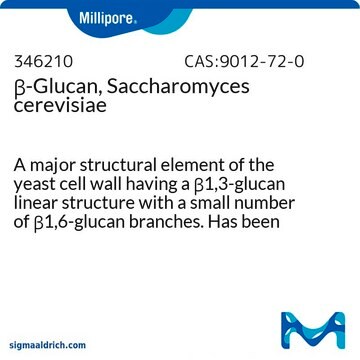67138
β-(1→3)-D-Glucanase from Helix pomatia
≥0.2 U/mg
Sign Into View Organizational & Contract Pricing
All Photos(1)
About This Item
Recommended Products
biological source
Helix pomatia
form
powder
specific activity
≥0.2 U/mg
storage temp.
−20°C
Looking for similar products? Visit Product Comparison Guide
Application
β-(1→3)-D-Glucanase from is used to digest β -1,3-glucan, which is a major component of cell walls. β-(1→3)-D-Glucanase from Helix pomatia has been used fto digest the cell walls of C. albicans .
Biochem/physiol Actions
Deletion of the C.albicans histidine kinase gene (CHK1) improves recognition by phagocytes through an increased exposure of cell wall b-1,3-glucans, which are readily digested by β-(1→3)-D-Glucanases .
Packaging
Bottomless glass bottle. Contents are inside inserted fused cone.
Unit Definition
One unit corresponds to the amount of enzyme which liberates 1 μmol of glucose from laminarin (Cat. No. 61340) per minute at pH 5.0 and 37 °C
Signal Word
Danger
Hazard Statements
Precautionary Statements
Hazard Classifications
Resp. Sens. 1
Storage Class Code
11 - Combustible Solids
WGK
WGK 1
Flash Point(F)
Not applicable
Flash Point(C)
Not applicable
Certificates of Analysis (COA)
Search for Certificates of Analysis (COA) by entering the products Lot/Batch Number. Lot and Batch Numbers can be found on a product’s label following the words ‘Lot’ or ‘Batch’.
Already Own This Product?
Find documentation for the products that you have recently purchased in the Document Library.
Customers Also Viewed
María de Medina-Redondo et al.
PloS one, 5(11), e14046-e14046 (2010-12-03)
The formation of the cell wall in Schizosaccharomyces pombe requires the coordinated activity of enzymes involved in the biosynthesis and modification of β-glucans. The β(1,3)-glucan synthase complex synthesizes linear β(1,3)-glucans, which remain unorganized until they are cross-linked to other β(1,3)-glucans
Alexander M Zakharenko et al.
Carbohydrate research, 346(2), 243-252 (2010-12-15)
The retaining endo-1,3-β-d-glucanase (EC 3.2.1.39) was isolated from the crystalline styles of the commercially available Vietnamese edible mussel Perna viridis. It catalyzes hydrolysis of β-1,3-bonds in glucans and enables to catalyze a transglycosylation reaction. Resources of mass-spectrometry for analysis of
Junio Cota et al.
Biochemical and biophysical research communications, 406(4), 590-594 (2011-03-01)
1,3-β-Glucan depolymerizing enzymes have considerable biotechnological applications including biofuel production, feedstock-chemicals and pharmaceuticals. Here we describe a comprehensive functional characterization and low-resolution structure of a hyperthermophilic laminarinase from Thermotoga petrophila (TpLam). We determine TpLam enzymatic mode of operation, which specifically
Julieta V Cabello et al.
The Plant journal : for cell and molecular biology, 69(1), 141-153 (2011-09-09)
Plants deal with cold temperatures via different signal transduction pathways. The HD-Zip I homologous transcription factors HaHB1 from sunflower and AtHB13 from Arabidopsis were identified as playing a key role in such cold response. The expression patterns of both genes
Amanda R Sena et al.
Anais da Academia Brasileira de Ciencias, 83(2), 599-609 (2011-06-01)
The enzyme glucanase from Moniliophthora perniciosa was produced in liquid medium and purified from the culture supernatant. A multivariate statistical approach (Response Surface Methodology - RSM) was employed to evaluate the effect of variables, including inducer (yeast extract) and fermentation
Our team of scientists has experience in all areas of research including Life Science, Material Science, Chemical Synthesis, Chromatography, Analytical and many others.
Contact Technical Service










